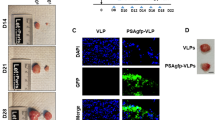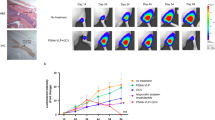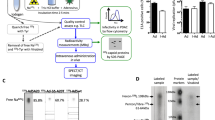Abstract
Effective treatment for recurrent, disseminated prostate cancer is notably limited. We have developed adenoviral vectors with a prostate-specific two-step transcriptional amplification (TSTA) system that would express therapeutic genes at a robust level to target metastatic disease. The TSTA system employs the prostate-specific antigen (PSA) promoter/enhancer to drive a potent synthetic activator, which in turn activates the expression of the therapeutic gene. In this study, we explored different configurations of this bipartite system and discovered that physical separation of the two TSTA components into E1 and E3 regions of adenovirus was able to enhance androgen regulation and cell-discriminatory expression. The TSTA vectors that express imaging reporter genes were assessed by noninvasive imaging technologies in animal models. The improved selectivity of the E1E3 configured vector was reflected in silenced ectopic expression in the lung. Significantly, the enhanced specificity of the E1E3 vector enabled the detection of lung metastasis of prostate cancer. An E1E3 TSTA vector that expresses the herpes simplex virus thymidine kinase gene can effectively direct positron emission tomography (PET) imaging of the tumor. The prostate-targeted gene delivery vectors with robust and cell-specific expression capability will advance the development of safe and effective imaging guided therapy for recurrent metastatic stages of prostate cancer.
This is a preview of subscription content, access via your institution
Access options
Subscribe to this journal
Receive 12 print issues and online access
$259.00 per year
only $21.58 per issue
Buy this article
- Purchase on Springer Link
- Instant access to full article PDF
Prices may be subject to local taxes which are calculated during checkout






Similar content being viewed by others
References
American Cancer Society. Cancer Facts and Figures 2007, p.4. American Cancer Society: Atlanta, GA, 2007.
Roehl KA, Han M, Ramos CG, Antenor JA, Catalona WJ . Cancer progression and survival rates following anatomical radical retropubic prostatectomy in 3478 consecutive patients: long-term results. J Urol 2004; 172: 910–914.
Pound CR, Partin AW, Eisenberger MA, Chan DW, Pearson JD, Walsh PC . Natural history of progression after PSA elevation following radical prostatectomy. JAMA 1999; 281: 1591–1597.
Dowling AJ, Tannock IF . Systemic treatment for prostate cancer. Cancer Treat Rev 1998; 24: 283–301.
Mabjeesh NJ, Zhong H, Simons JW . Gene therapy of prostate cancer: current and future directions. Endocr Relat Cancer 2002; 9: 115–139.
Wu L, Johnson M, Sato M . Transcriptionally targeted gene therapy to detect and treat cancer. Trends Mol Med 2003; 9: 421–429.
Figueiredo ML, Sato M, Johnson M, Wu L . Specific targeting of gene therapy to prostate cancer using a two-step transcriptional amplification system. Future Oncol 2006; 2: 391–406.
Sato M, Johnson M, Zhang L, Gambhir SS, Carey M, Wu L . Functionality of androgen receptor-based gene expression imaging in hormone refractory prostate cancer. Clin Cancer Res 2005; 11: 3743–3749.
Wu L, Matherly J, Smallwood A, Adams JY, Billick E, Belldegrun A et al. Chimeric PSA enhancers exhibit augmented activity in prostate cancer gene therapy vectors. Gene Therapy 2001; 8: 1416–1426.
Sato M, Johnson M, Zhang L, Zhang B, Le K, Gambhir SS et al. Optimization of adenoviral vectors to direct highly amplified prostate-specific expression for imaging and gene therapy. Mol Ther 2003; 8: 726–737.
Zhang L, Adams JY, Billick E, Ilagan R, Iyer M, Le K et al. Molecular engineering of a two-step transcription amplification (TSTA) system for transgene delivery in prostate cancer. Mol Ther 2002; 5: 223–232.
Iyer M, Wu L, Carey M, Wang Y, Smallwood A, Gambhir SS . Two-step transcriptional amplification as a method for imaging reporter gene expression using weak promoters. Proc Natl Acad Sci USA 2001; 98: 14595–14600.
Lilja H . A kallikrein-like serine protease in prostatic fluid cleaves the predominant seminal vesicle protein. J Clin Invest 1985; 76: 1899–1903.
Stamey TA, Yang N, Hay AR, McNeal JE, Freiha FS, Redwine E . Prostate-specific antigen as a serum marker for adenocarcinoma of the prostate. N Engl J Med 1987; 317: 909–916.
Gelmann EP . Molecular biology of the androgen receptor. J Clin Oncol 2002; 20: 3001–3015.
Roudier MP, True LD, Higano CS, Vesselle H, Ellis W, Lange P et al. Phenotypic heterogeneity of end-stage prostate carcinoma metastatic to bone. Hum Pathol 2003; 34: 646–653.
Shah RB, Mehra R, Chinnaiyan AM, Shen R, Ghosh D, Zhou M et al. Androgen-independent prostate cancer is a heterogeneous group of diseases: lessons from a rapid autopsy program. Cancer Res 2004; 64: 9209–9216.
Adams JY, Johnson M, Sato M, Berger F, Gambhir SS, Carey M et al. Visualization of advanced human prostate cancer lesions in living mice by a targeted gene transfer vector and optical imaging. Nat Med 2002; 8: 891–896.
Thomas CE, Ehrhardt A, Kay MA . Progress and problems with the use of viral vectors for gene therapy. Nat Rev Genet 2003; 4: 346–358.
Johnson M, Sato M, Burton JB, Gambhir SS, Carey M, Wu L . Micro-PET/CT monitoring of herpes thymidine kinase suicide gene therapy in a prostate cancer xenograft: the advantage of a cell-specific transcriptional targeting approach. Mol Imaging 2005; 4: 463–472.
Dzojic H, Cheng WS, Essand M . Two-step amplification of the human PPT sequence provides specific gene expression in an immunocompetent murine prostate cancer model. Cancer Gene Ther 2007; 14: 233–240.
Hattori Y, Maitani Y . Two-step transcriptional amplification-lipid-based nanoparticles using PSMA or midkine promoter for suicide gene therapy in prostate cancer. Cancer Sci 2006; 97: 787–798.
Ilagan R, Pottratz J, Le K, Zhang L, Wong SG, Ayala R et al. Imaging mitogen-activated protein kinase function in xenograft models of prostate cancer. Cancer Res 2006; 66: 10778–10785.
Qiao J, Doubrovin M, Sauter BV, Huang Y, Guo ZS, Balatoni J et al. Tumor-specific transcriptional targeting of suicide gene therapy. Gene Therapy 2002; 9: 168–175.
Segawa T, Takebayashi H, Kakehi Y, Yoshida O, Narumiya S, Kakizuka A . Prostate-specific amplification of expanded polyglutamine expression: a novel approach for cancer gene therapy. Cancer Res 1998; 58: 2282–2287.
Wang Y, Iyer M, Annala A, Wu L, Carey M, Gambhir SS . Noninvasive indirect imaging of vascular endothelial growth factor gene expression using bioluminescence imaging in living transgenic mice. Physiol Genomics 2006; 24: 173–180.
Xie X, Xia W, Li Z, Kuo HP, Liu Y, Li Z et al. Targeted expression of BikDD eradicates pancreatic tumors in noninvasive imaging models. Cancer Cell 2007; 12: 52–65.
West AG, Huang S, Gaszner M, Litt MD, Felsenfeld G . Recruitment of histone modifications by USF proteins at a vertebrate barrier element. Mol Cell 2004; 16: 453–463.
Zhang L, Johnson M, Le KH, Sato M, Ilgan R, Iyer M et al. Interrogating androgen receptor function in recurrent prostate cancer. Cancer Res 2003; 63: 4552–4560.
Lee C, Sutkowski DM, Sensibar JA, Zelner D, Kim I, Amsel I et al. Regulation of proliferation and production of prostate-specific antigen in androgen-sensitive prostatic cancer cells, LNCaP, by dihydrotestosterone. Endocrinology 1995; 136: 796–803.
Sramkoski RM, Pretlow II TG, Giaconia JM, Pretlow TP, Schwartz S, Sy MS et al. A new human prostate carcinoma cell line, 22Rv1. In Vitro Cell Dev Biol Anim 1999; 35: 403–409.
Klein KA, Reiter RE, Redula J, Moradi H, Zhu XL, Brothman AR et al. Progression of metastatic human prostate cancer to androgen independence in immunodeficient SCID mice. Nat Med 1997; 3: 402–408.
Bernt KM, Ni S, Gaggar A, Li ZY, Shayakhmetov DM, Lieber A . The effect of sequestration by nontarget tissues on anti-tumor efficacy of systemically applied, conditionally replicating adenovirus vectors. Mol Ther 2003; 8: 746–755.
Johnson M, Huyn S, Burton JB, Sato M, Wu L . Differential biodistribution of adenoviral vector in vivo as monitored by bioluminescence imaging and quantitative polymerase chain reaction. Hum Gene Ther 2006; 17: 1262–1269.
Brakenhielm E, Burton JB, Johnson M, Chavarria N, Morizono K, Chen I et al. Modulating metastasis by a lymphangiogenic switch in prostate cancer. Int J Cancer 2007; 121: 2153–2161.
Burton JB, Johnson M, Sato M, Koh SBS, Mulholland D, Stout D et al. Adenovirus mediated gene expression imaging to directly detect sentinel lymph node metastasis of prostate cancer. Nat Med (in press).
Hauser MA, Robinson A, Hartigan-O'Connor D, Williams-Gregory DA, Buskin JN, Apone S et al. Analysis of muscle creatine kinase regulatory elements in recombinant adenoviral vectors. Mol Ther 2000; 2: 16–25.
Chenuaud P, Larcher T, Rabinowitz JE, Provost N, Joussemet B, Bujard H et al. Optimal design of a single recombinant adeno-associated virus derived from serotypes 1 and 2 to achieve more tightly regulated transgene expression from nonhuman primate muscle. Mol Ther 2004; 9: 410–418.
Jiang L, Rampalli S, George D, Press C, Bremer EG, O'Gorman MR et al. Tight regulation from a single tet-off rAAV vector as demonstrated by flow cytometry and quantitative, real-time PCR. Gene Therapy 2004; 11: 1057–1067.
Bader P, Burkhard FC, Markwalder R, Studer UE . Disease progression and survival of patients with positive lymph nodes after radical prostatectomy. Is there a chance of cure? J Urol 2003; 169: 849–854.
Gambhir SS . Molecular imaging of cancer with positron emission tomography. Nat Rev Cancer 2002; 2: 683–693.
Goverdhana S, Puntel M, Xiong W, Zirger JM, Barcia C, Curtin JF et al. Regulatable gene expression systems for gene therapy applications: progress and future challenges. Mol Ther 2005; 12: 189–211.
Vilaboa N, Voellmy R . Regulatable gene expression systems for gene therapy. Curr Gene Ther 2006; 6: 421–438.
Woraratanadharm J, Rubinchik S, Yu H, Dong JY . Novel system uses probasin-based promoter, transcriptional silencers and amplification loop to induce high-level prostate expression. BMC Biotechnol 2007; 7: 9.
He TC, Zhou S, da Costa LT, Yu J, Kinzler KW, Vogelstein B . A simplified system for generating recombinant adenoviruses. Proc Natl Acad Sci USA 1998; 95: 2509–2514.
Bell AC, West AG, Felsenfeld G . The protein CTCF is required for the enhancer blocking activity of vertebrate insulators. Cell 1999; 98: 387–396.
Wu JC, Sundaresan G, Iyer M, Gambhir SS . Noninvasive optical imaging of firefly luciferase reporter gene expression in skeletal muscles of living mice. Mol Ther 2001; 4: 297–306.
Loening AM, Gambhir SS . AMIDE: a free software tool for multimodality medical image analysis. Mol Imaging 2003; 2: 131–137.
Acknowledgements
We deeply appreciate the help of W Ladno, J Edwards and Dr D Stout for their skillful assistance in PET/CT imaging, and Baohui Zhang for technical assistance. The CWR22Rv1 cell line and the polyclonal anti-HSV-tk antibody were kindly provided by Dr David Agus and Dr Margaret Black, respectively. This work is supported by RO1 CA101904-01, Prostate Cancer Foundation and Department of Defense Congressionally Directed Medical Research Program DAMD17-03-1-0095 (to LW) and postdoctoral fellowship, PC020531 (to MS).
Author information
Authors and Affiliations
Corresponding author
Rights and permissions
About this article
Cite this article
Sato, M., Figueiredo, M., Burton, J. et al. Configurations of a two-tiered amplified gene expression system in adenoviral vectors designed to improve the specificity of in vivo prostate cancer imaging. Gene Ther 15, 583–593 (2008). https://doi.org/10.1038/gt.2008.19
Received:
Revised:
Accepted:
Published:
Issue Date:
DOI: https://doi.org/10.1038/gt.2008.19



